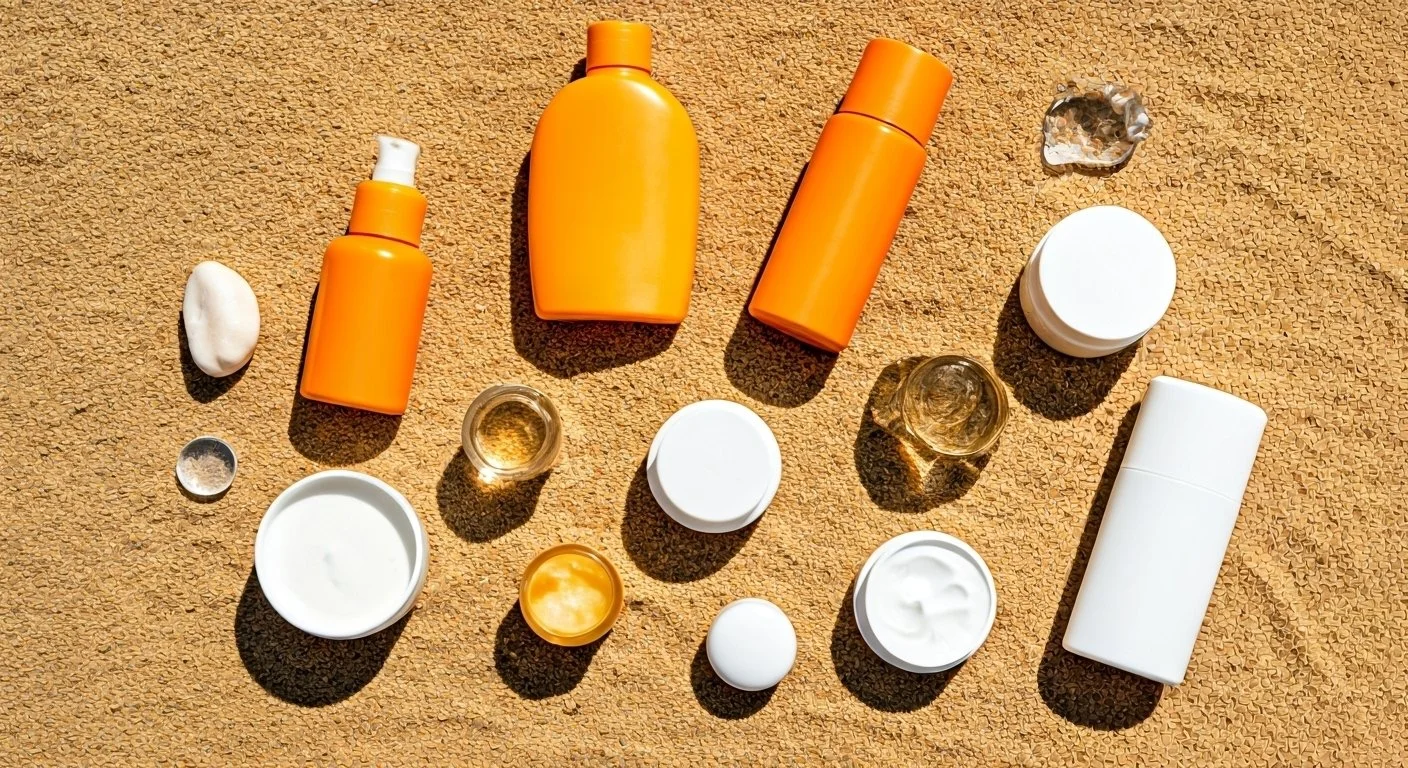Beach Skincare Essentials: Your Complete Dermatologist-Approved Guide to Sun-Safe Beauty
Beach days are among life's greatest pleasures—the feel of warm sand, refreshing ocean breezes, and that perfect sun-kissed glow. However, spending time in the sun, saltwater, and wind can wreak havoc on your skin if you're not properly prepared. The combination of intense UV rays, dehydrating salt air, and environmental stressors requires a strategic approach to skincare that goes far beyond just throwing on some sunscreen. With the right beach skincare essentials, you can protect your skin, maintain your glow, and prevent both immediate damage and long-term aging.
Quick Answer: Essential beach skincare includes broad-spectrum SPF 30+ sunscreen, gentle cleansers for salt removal, antioxidant serums for protection, rich moisturizers for hydration, and soothing after-sun treatments. Professional prep with chemical peels and proper product selection can enhance your skin's resilience to beach environments.
Understanding Beach-Specific Skin Challenges
The Triple Threat: Sun, Salt, and Wind
Beach environments create a perfect storm of skin stressors that require specialized care. UV radiation is intensified by reflection off sand and water, potentially doubling your exposure. Saltwater, while having some antimicrobial benefits, is extremely dehydrating and can disrupt your skin's natural barrier. Ocean winds accelerate moisture loss and can cause micro-irritation that makes your skin more vulnerable to sun damage.
Why Regular Skincare Isn't Enough
Your everyday skincare routine, while important, isn't designed to handle the extreme conditions of beach environments. Regular moisturizers may not provide adequate protection against salt and sun, standard cleansers might not effectively remove waterproof sunscreen and salt buildup, and typical serums may not offer sufficient antioxidant protection against heightened oxidative stress.
The key is adapting your routine with beach-specific formulations and protective strategies that work synergistically to maintain healthy skin throughout your beach activities.
The Non-Negotiable Beach Skincare Foundation
Sunscreen: Your Primary Defense
Broad-Spectrum Protection is Essential Choose sunscreens that offer broad-spectrum protection against both UVA and UVB rays with at least SPF 30. UVB rays cause immediate burning, while UVA rays penetrate deeper, causing premature aging and increasing cancer risk. ADAM Invisible Shield SPF 50 provides high-level protection without the heavy, greasy feeling that can be uncomfortable in beach heat.
Water-Resistant Formulations Beach activities require water-resistant sunscreens that maintain protection for 40-80 minutes of swimming or sweating. However, "water-resistant" doesn't mean waterproof—you still need to reapply every two hours or immediately after swimming, toweling off, or excessive sweating.
Application Strategy Use approximately one ounce (a shot glass full) of sunscreen for your entire body, and don't forget often-missed areas like ears, feet, hands, and the back of your neck. Apply 15-30 minutes before sun exposure to allow proper absorption.
Professional Pre-Beach Preparation
Chemical Peels can be strategically timed before beach season to remove damaged surface layers and improve your skin's resilience. However, timing is crucial—schedule treatments at least 2-4 weeks before significant sun exposure to avoid increased photosensitivity.
Professional Consultation A consultation with Dr. Monica Rani can help identify your skin's specific vulnerabilities and create a personalized beach skincare plan. This is especially important if you have sensitive skin, a history of sun damage, or take medications that increase photosensitivity.
Essential Pre-Beach Skincare Routine
Morning Preparation
Step 1: Gentle Cleansing Start with ADAM Glyco 10 Crème Cleanser to remove overnight buildup and prepare your skin for protective products. The glycolic acid provides gentle exfoliation that helps sunscreen apply more evenly.
Step 2: Antioxidant Protection Apply a vitamin C serum or antioxidant treatment to help neutralize free radicals generated by UV exposure. This creates an additional layer of protection against oxidative damage.
Step 3: Lightweight Hydration Use ADAM Ultra Lite Hydration to maintain moisture balance without creating a heavy base that might interfere with sunscreen application.
Step 4: Broad-Spectrum Sunscreen Apply your chosen sunscreen as the final step, ensuring complete coverage of all exposed areas.
Strategic Product Timing
Apply skincare products in layers, allowing 2-3 minutes between each step for proper absorption. This prevents pilling and ensures each product can work effectively. Start your routine 20-30 minutes before heading to the beach to allow full absorption and activation of active ingredients.
Beach Bag Beauty Essentials
Multi-Purpose Products for Space Efficiency
Tinted Moisturizer with SPF For those who prefer light coverage, tinted moisturizers with SPF provide color correction, hydration, and sun protection in one step. Choose formulas specifically designed for beach use with water-resistant properties.
Lip Protection Your lips are particularly vulnerable to UV damage due to their thin skin and lack of melanin. Use a broad-spectrum lip balm with at least SPF 30. Look for formulas that won't wash off easily and provide lasting moisture against salt and wind.
Waterproof Eye Protection If you wear makeup to the beach, choose waterproof mascara and eyeliner that won't run or smudge. However, remember that makeup should supplement, not replace, proper sunscreen application around the delicate eye area.
Emergency Skin Soothers
Cooling Facial Mists Pack a facial mist for instant refreshment and hydration throughout the day. Look for formulas with soothing ingredients like aloe vera or cucumber extract that can provide immediate relief if skin becomes irritated.
Multi-Purpose Healing Balm ADAM Calm Cream can serve multiple purposes at the beach—from soothing minor sunburn to protecting sensitive areas prone to chafing or irritation.
Environmental Considerations and Product Selection
Reef-Safe Sunscreen Choices
Choose sunscreens free from oxybenzone and octinoxate, which can harm coral reefs and marine ecosystems. Mineral sunscreens containing zinc oxide and titanium dioxide are generally reef-safe and often gentler on sensitive skin.
EltaMD UV Clear Broad Spectrum SPF 46 Tinted offers excellent protection with zinc oxide as the active ingredient, making it both effective and environmentally conscious.
Climate-Specific Adjustments
Humid Beach Climates In high humidity, choose lighter textures and gel-based formulations that won't feel suffocating on your skin. Increase the frequency of gentle cleansing to prevent buildup that can lead to breakouts.
Dry, Sunny Locations Desert beaches or dry coastal areas require richer moisturizers and more frequent hydration. Consider bringing a heavier night cream for evening repair even if you typically use lighter formulations.
Post-Beach Recovery and Repair
Immediate Post-Sun Care
Gentle but Thorough Cleansing
Remove all sunscreen, salt, and sand with a gentle cleanser that won't strip your already-stressed skin. ADAM Benzoyl 10 wash can be used 2-3 times per week if you're prone to beach-related breakouts, but avoid daily use which might over-dry sun-exposed skin.
Immediate Hydration Apply moisturizer to damp skin within minutes of cleansing to lock in hydration. ADAM Moisture Boost provides intensive hydration that helps repair the barrier damage that can occur from sun, salt, and wind exposure.
Evening Restoration Routine
Deep Repair Treatment Use ADAM Biocell Repair Moisturizer in the evening to support overnight skin recovery. The combination of reparative ingredients helps address the oxidative stress accumulated during beach exposure.
Gentle Exfoliation 2-3 days after beach exposure, gentle exfoliation with ADAM Alpha Beta Pads can help remove any lingering dead skin cells and prepare your skin for better product absorption.
Antioxidant Support Continue using antioxidant treatments for several days after beach exposure to help neutralize any lingering free radical damage. ADAM Triple Antioxidant Cream provides comprehensive protection and repair support.
Professional Treatments for Beach Season
Pre-Season Skin Preparation
Customized Treatment Planning Schedule a consultation 4-6 weeks before beach season to assess your skin's condition and plan appropriate treatments. This timing allows for proper healing and optimal skin condition before sun exposure.
Laser Treatments for Even Tone Laser treatments can address existing sun damage, uneven pigmentation, and improve overall skin texture before beach season. The Aerolase laser is particularly effective for treating sun damage while being safe for all skin tones.
Post-Beach Season Recovery
Damage Assessment and Treatment After beach season, professional evaluation can identify any damage that occurred despite protective measures. Early intervention with appropriate treatments can prevent minor damage from becoming permanent.
Intensive Repair Protocols Professional treatments like deeper chemical peels, laser resurfacing, or advanced facials can help repair accumulated sun damage and restore your skin's health and appearance.
Special Situations and Skin Types
Acne-Prone Skin at the Beach
Beach environments can either improve or worsen acne depending on your approach. Salt water has natural antimicrobial properties that can help some people, but sun exposure can thicken skin and trap oil, potentially worsening breakouts.
Protective Strategy:
Use non-comedogenic, oil-free sunscreens
Cleanse immediately after beach activities
Consider the ADAM MASKNE KIT for comprehensive acne management during beach season
Sensitive Skin Considerations
Sensitive skin requires extra protection and gentler formulations. Choose fragrance-free, hypoallergenic products and always patch-test new products before beach use.
Recommended Approach:
Use mineral sunscreens exclusively
Limit initial sun exposure to build tolerance gradually
Keep soothing treatments like ADAM Calm Cream readily available
Mature Skin Beach Care
Mature skin may be more vulnerable to sun damage due to decreased natural barrier function and slower repair processes.
Enhanced Protection Strategy:
Use higher SPF sunscreens (50+)
Apply antioxidant treatments morning and evening
Consider professional treatments like laser therapy to address existing damage before beach season
Beach Skincare Mistakes to Avoid
Timing Errors
Applying Sunscreen Too Late Sunscreen needs 15-30 minutes to activate fully. Applying it right before beach activities leaves you vulnerable during the initial exposure period.
Skipping Reapplication Even the best water-resistant sunscreens lose effectiveness over time. Set phone alarms every two hours as reapplication reminders.
Product Selection Mistakes
Using Expired Sunscreen Sunscreen loses effectiveness over time, especially when exposed to heat. Check expiration dates and replace products stored in hot cars or beach bags.
Mixing Incompatible Ingredients Some skincare ingredients can increase photosensitivity or become less effective when combined. Avoid using retinoids or high-concentration acids immediately before beach exposure.
Coverage Gaps
Missing Critical Areas Ears, feet, hands, eyelids, and lips are frequently missed during sunscreen application but are highly vulnerable to damage.
Under-Application Most people apply only 25-50% of the recommended amount of sunscreen, significantly reducing protection levels.
Building Your Personalized Beach Kit
Essential Products Checklist
Sun Protection:
Broad-spectrum SPF 30+ sunscreen for face and body
Water-resistant lip balm with SPF
Wide-brimmed hat and UV-protective sunglasses
Cleansing and Care:
Gentle cleanser for salt and sunscreen removal
Hydrating toner or mist for refreshment
Rich moisturizer for barrier repair
Emergency Items:
Soothing gel for minor burns or irritation
Antioxidant serum for enhanced protection
Healing balm for multipurpose use
Seasonal Adjustments
Early Season (Spring): Focus on gradual exposure and building skin tolerance. Use higher protection levels and limit initial beach time.
Peak Season (Summer): Maintain consistent protection routines and be vigilant about reapplication during longer beach days.
Late Season (Fall): Begin repair and recovery treatments while continuing protection for remaining warm days.
Long-Term Skin Health Strategies
Prevention vs. Treatment Philosophy
The most effective approach to beach skincare emphasizes prevention over treatment. While professional treatments can address existing damage, preventing it in the first place is always preferable and more cost-effective.



